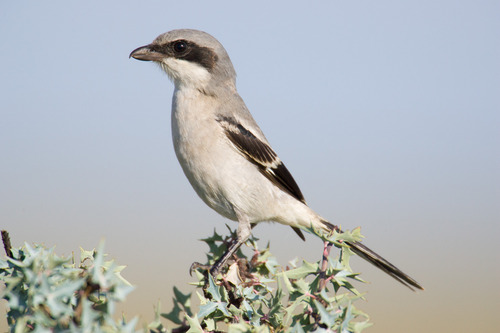
Loggerhead Shrike
The Loggerhead Shrike ( *Lanius ludovicianus*), often called the "butcherbird," is a unique songbird known for its predatory behavior. Unlike other songbirds, it impales its prey on thorns, barbed wire, or other sharp objects. This behavior allows them to consume larger prey piecemeal and store food for later. Ecologically, they play a role in controlling insect and small vertebrate populations. They hold a somewhat unusual place in human perception, being both admired for their hunting prowess and sometimes viewed with unease due to their impaling habit.
18-23 cm
Length
28-32 cm
Wingspan
Near Threatened
Conservation Status
Distribution
The Loggerhead Shrike is found across North America, ranging from southern Canada through the United States and into Mexico. It has a complex migratory pattern, with northern populations generally moving south for the winter, while southern populations may be resident year-round. They are typically found at lower to moderate elevations.
Lifespan
The average lifespan in the wild is difficult to determine, but individuals have been known to live up to 6 years or more. Captive birds may live longer.
Loggerhead Shrike's Habitat
Habitat Types
Open grasslands, Savannas, Agricultural fields with scattered trees and shrubs, Desert scrub
Climate Zones
Temperate, Subtropical, Arid
Adaptations
Loggerhead Shrikes prefer open habitats with perches for hunting and nesting. They require areas with suitable substrates for impaling prey, such as thorny bushes or barbed wire fences. Their strong, hooked bill is an adaptation for tearing flesh.
Variations
Several subspecies of Loggerhead Shrike are recognized, differing slightly in plumage and geographic distribution. For example, the San Clemente Loggerhead Shrike (*Lanius ludovicianus mearnsi*) is a critically endangered subspecies found only on San Clemente Island off the coast of California.
Appearance
Breeding Plumage
Plumage is generally similar year-round.
Seasonal Feather Changes
Minimal seasonal variation; some individuals may show slightly brighter plumage during the breeding season.
Sex Based Plumage Differences
Males and females have very similar plumage. Subtle differences may exist in the intensity of the black mask or gray crown, but these are often difficult to distinguish in the field.
Notable Features
Black mask extending through the eye, Gray crown and back, White underparts, Black wings with white patches, Hooked bill, Relatively large head for a songbird (hence "Loggerhead")
Diet and Feeding
Primary Foods
Insects (grasshoppers, beetles, crickets), Small vertebrates (mice, lizards, small birds), Spiders, Occasionally, carrion
Foraging Behavior
Loggerhead Shrikes are sit-and-wait predators. They perch on elevated locations like fence posts, utility wires, or branches, scanning for prey. Once prey is spotted, they swoop down to capture it. They are known for their habit of impaling prey on thorns or barbed wire.
Specializations
The hooked bill is specialized for tearing flesh. The impaling behavior is a unique adaptation that allows them to consume prey larger than they could otherwise handle and to store food for later consumption.
Seasonal Diet Variations
Diet can vary seasonally depending on prey availability. Insects may be more prevalent in the diet during warmer months, while small vertebrates may become more important during colder periods.
Behavior
Social Structure
Loggerhead Shrikes are generally solitary or found in pairs, especially during the breeding season. They are highly territorial.
Communication
Harsh, rasping calls, Chattering vocalizations, Visual displays, including wing-flicking and tail-bobbing
Migration
Northern populations are migratory, flying south for the winter. Southern populations may be resident year-round or exhibit partial migration. Migration routes and timing are complex and vary by region.
Territorial or Group Behaviors
Loggerhead Shrikes are highly territorial, defending their breeding and feeding territories aggressively against intruders, including other shrikes and potential predators.
Conservation
Threats
Habitat loss and degradation (due to agriculture, urbanization, and other development), Pesticide use (reducing prey populations and potentially causing direct poisoning), Collisions with vehicles, Loss of suitable nesting sites (e.g., thorny shrubs), Climate change (potentially affecting prey availability and distribution)
Protection Programs
Habitat restoration and management efforts, Monitoring programs to track population trends, Research on the impacts of pesticides and other threats
Local National Laws
The Loggerhead Shrike is protected under the Migratory Bird Treaty Act in the United States and Canada. Some states and provinces also have specific regulations to protect the species.
Population Trend
Decreasing
Population Estimates
The global population is estimated to be around 6.8 million individuals, but populations have declined significantly in many areas, particularly in the northeastern United States and southeastern Canada.
Interesting Facts
They are nicknamed "butcherbirds" due to their habit of impaling prey.
This behavior serves both as a way to subdue larger prey and to store food for later consumption.
They can kill prey larger than themselves.
By using their strong beak and impaling technique, they can subdue and consume relatively large vertebrates.
They sometimes mimic the calls of other birds.
The purpose of this mimicry is not fully understood, but it may be used to lure prey or to deter competitors.
Faqs about Loggerhead Shrike
Why do Loggerhead Shrikes impale their prey?
Impaling serves multiple purposes. It allows them to secure and tear apart prey that is too large to swallow whole, and it also creates a food cache (a 'larder') for later consumption.
Are Loggerhead Shrikes dangerous to humans?
No, Loggerhead Shrikes are not dangerous to humans. They are relatively small birds and primarily prey on insects and small vertebrates.
Why are Loggerhead Shrike populations declining?
The primary reasons for their decline are habitat loss and degradation, pesticide use, and collisions with vehicles. Loss of suitable nesting sites and climate change are also contributing factors.
Copyright @ Nature Style Limited. All Rights Reserved.
 English
English